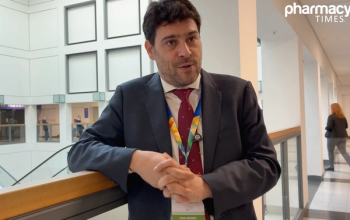
Hypertension Management in Older Adults
Pharmacists play an important role in assisting with hypertension treatment by helping to modify blood pressure therapies when patients experience adverse effects or helping if a patient has difficulty remembering to take their medications.
Hypertension arises from a gradual increase in pressure as blood pushes against the walls of arteries, veins, and capillaries.1 Incidences of hypertension are increased in the elderly due to reduced elasticity of blood vessel walls from elastin loss, increased vessel calcification, as well as the progression of atherosclerosis.2
Aging can also result in the aorta becoming thick, stiff, and less flexible, because of changes to connective tissue.3 The heart has to work harder to overcome this, causing hypertrophy of the heart muscle.3 Surrounding arteries can become stiffer and may further harden as fatty plaques deposit, eventually leading to narrowing or complete blockage of the vessel.3
Managing hypertension is important to minimize complications of cardiovascular disease, stroke, and renal failure. When this disease is appropriately managed, patients can significantly improve their life expectancy, as well as limit medical costs from disease progression.
Patients with the highest risk of complications from hypertension are those 65 years of age or older. Blood pressure should be frequently monitored in these patients due to patient-specific factors including decreased organ function, their risk of medication-related adverse effects, and higher occurrences of myocardial infarction or stroke. The instance of polypharmacy in older adults—use of 4 or more medications—increases the need to prioritize management of blood pressure treatment.
Pharmacists have the ability to improve patient outcomes by assisting with the use of antihypertensive medications, providing lifestyle management techniques, and identifying patient drug utilization difficulties. This article will review the frequency of hypertension in older adults, blood pressure goals in the elderly, pharmacological or nonpharmacological treatment options in this population, how to manage orthostatic hypotension, and contraindicated medications.
Hypertension Classification
According to the 2017 American College of Cardiology (ACC)/American Heart Association (AHA) Guideline for the Prevention, Detection, Evaluation, and Management of High Blood Pressure in Adults, patients are classified into the stage of hypertension after obtaining 2-3 blood pressure measurements, during at least 3 separate occasions. Normal blood pressure, elevated, stage 1, and stage 2 classes, are defined below.4
- Normal:systolic <120 mmHg and diastolic of <80 mmHg.
- Elevated blood pressure: systolic between 120- 129 mmHg and diastolic <80 mmHg.
- Stage 1: systolic between 130-139 mmHg or diastolic between 80-89 mmHg.
- Stage 2: systolic readings > 140 mmHg or diastolic of > 90 mmHg.4
A study was conducted across the United States to determine how blood pressure diagnostic criteria from the 2017 ACC/AHA guidelines impacted treatment in adults. Data were collected from a National Health and Nutrition Examination Survey (NHANES) from 9623 participants. Each patient had hypertension results pulled from 3 standardized blood pressure measurements.
Candidates were separated into several age categories, but all patients were required to be at least 20 years of age with every systolic blood pressure (SBP) and diastolic blood pressure (DBP) reading obtained at study visits. Blood pressure was measured by a trained physician using a mercury sphygmomanometer, and patients were also separated out into their risk for cardiovascular disease (CVD), with the highest risk of CVD (>10%) amongst those with a previous history of CVD.5
Results of the study showed that the majority of the patients were non-Hispanic whites, had normal blood pressure (42.3%), and were 38 years of age. Those found to have elevated blood pressure were around 60 years of age (12.1%).
The study concluded that overall hypertension prevalence was more frequently diagnosed in patients using the 2017 ACC/AHA guidelines (45.6%) versus the JNC7 guideline parameters across all subgroups, and more antihypertensive medications were recommended to patients with concurrent disease states or > 65 years old.
Diagnosis is important because with appropriate nonpharmacological interventions and drug therapy, chances of CVD diagnosis can be substantially reduced for at-risk patients, particularly in the elderly.5
Blood Pressure Goals
Goals for lowering blood pressure may vary from patient to patient. Drastically lowering blood pressure can be dangerous in the elderly population. Blood pressure goals should be balanced with patient risk factors and the patient’s state of health. Goals may differ for patients who reside in long-term care living facilities, but for those who are noninstitutionalized, it is recommended that those older than 65 with an SBP > 130 mmHg reduce this to < 130 mmHg.
Patients who have a high number of comorbidities or short life expectancy may have better outcomes with a team-based approach that is assessing risk versus benefit of blood lowering goals and drug therapy.Most benefit has been seen in SBP-specific lowering, when SBP is >160 mmHg and a DBP that varies < 90, 95, or 110 mmHg.
Previous randomized controlled trials have not shown that harm outweighs the benefit for treatment of hypertension in the elderly, but that antihypertensive agents are among the few treatments that reduce mortality in frail patients.4
Orthostatic Hypotension
Orthostatic hypotension (OH) is a sustained reduction of SBP >20 mmHg or DBP >10 mmHg within 3 minutes of standing. Blood pressure must be collected when a person is in standing and sitting position and is important to identify in elderly patients to reduce their risk of falls.
When treating this condition, the goals are to improve symptoms versus targeting haphazard blood pressure levels.6 Pharmacological agents could be the culprit of OH. In the ALLHAT trial, first-line antihypertensive agents were compared in patients with fatal coronary heart disease or nonfatal myocardial infarction.
Patients 65 years of age or older were separately analyzed to formulate the relative risk for falls, syncope, and OH. Approximately 23,964 patients were analyzed in this sub-analysis, with most being female (45%) and at least 69 years of age. More than 267 falls were found and 249 cases of OH.
The results of this analysis found no significant difference to cumulative events from random drug assignment, but the study did find that after a 1-year follow up with amlodipine, patients seem to have an increased chance of falls compared to using lisinopril or chlorthalidone. This study concluded that there are no specific antihypertensive medications that increase the incidence of falls or OH, but treatment should be carefully selected and monitored in each patient.7
Signs and symptoms of OH should be addressed with patients and can include feelings of dizziness, blurred vision, fatigue, or headache. Other causes of OH could be anemia, dehydration, and medical conditions that impact the autonomic nervous system, such as Parkinson disease. Treatment of OH could be achieved by modifying the antihypertensive agent or using nonpharmacological treatments.
Patients may try avoidance of alcoholic beverages, slowly rising from sitting to standing, slow deep breathing, or eating small, frequent meals.5 If medications are necessary, use of fludrocortisone to increase intravascular volume, or midodrine to increase vascular resistance may be alternative options.6
Nonpharmacological Treatment
Nonpharmacological treatment options can be combined with medication therapies to help elderly patients better manage blood pressure. Weight loss for obese adults to ideal body weight may be helpful to reduce blood pressure by 5 mmHg. Diet may be a consideration for patients and, if appropriate, use of the DASH diet. This would be consumption of higher amounts of fruits, vegetables, whole grains, and low-fat dairy.
Sodium reduction to less than 1500 mg per day can also help to reduce blood pressure by 5-6 mmHg. Physical activity may be most beneficial for patients since this helps to improve bone health and reduces CVD. Customize diet and exercise plans to meet patient needs but aim for 150 minutes of exercise each week.4
Pharmacological Treatment Options
No specific agents have proven to be more effective in antihypertensive effects among the elderly; however. agents should be selected based on patient specific factors, including the impact of a drug adverse effect profile on an individual or their ethnicity.4 Agents that should be avoided in patients over 65 years of age who are at an increased risk of falls from OH include alpha-1 blockers, such as doxazosin.8
Clonidine and nifedipine should also be avoided because of the high potential of hypotension. Other adverse effects of clonidine that could be dangerous in certain older populations are central nervous system effects and incidences of bradycardia.8 Pharmacists can help patients in medication adherence by educating them about the importance of taking their medications on a daily basis, assisting with creating a medication schedule to help minimize medication adverse effects, and alerting physicians when changes to therapy may be needed.
Conclusion
Research related to hypertension management in older adults has increased, but there is still more to be done. Current guidelines for hypertension treatment in adults have outlined treatment considerations in the elderly and numerous studies have been conducted to determine the effects of antihypertensive agents in the elderly population.
Pharmacists play a part in assisting patients by helping to modify blood pressure therapies when patients experience adverse effects or helping if a patient has difficulty remembering to take their medications. When hypertension is properly managed by all providers, it improves medication outcomes and minimizes disease-related complications.
References
- What is High Blood Pressure? www.heart.org. https://www.heart.org/en/health-topics/high-blood-pressure/the-facts-about-high-blood-pressure/what-is-high-blood-pressure. Published October 31, 2016. Accessed June 23, 2020.
- Aging changes in the heart and blood vessels: MedlinePlus Medical Encyclopedia. (2020, July 02). Retrieved July 23, 2020, from https://medlineplus.gov/ency/article/004006.htm
- A Mechanism by Which Hypertension Accelerates Atherosclerosis. (2018, November 06). Retrieved July 23, 2020, from https://www.fightaging.org/archives/2018/11/a-mechanism-by-which-hypertension-accelerates-atherosclerosis/
- Whelton PK, Paul K. WheltonSearch for more papers by this author, Carey RM, et al. 2017 ACC/AHA/AAPA/ABC/ACPM/AGS/APhA/ASH/ASPC/NMA/PCNA Guideline for the Prevention, Detection, Evaluation, and Management of High Blood Pressure in Adults: A Report of the American College of Cardiology/American Heart Association Task Force on Clinical Practice Guidelines. Hypertension. https://www.ahajournals.org/doi/10.1161/HYP.0000000000000065. Published November 13, 2017. Accessed June 23, 2020.
- Muntner P, Carey RM, Gidding S, et al. Potential US Population Impact of the 2017 ACC/AHA High Blood Pressure Guideline. Circulation. 2018;137(2):109-118. doi:10.1161/CIRCULATIONAHA.117.032582
- Arnold AC, Raj SR. Orthostatic Hypotension: A Practical Approach to Investigation and Management. Can J Cardiol. 2017;33(12):1725-1728. doi: 10.1016/j.cjca.2017.05.007
- Juraschek SP, Simpson LM, Davis BR, Beach JL, Ishak A, Mukamal KJ. Effects of Antihypertensive Class on Falls, Syncope, and Orthostatic Hypotension in Older Adults: The ALLHAT Trial. Hypertension. 2019;74(4):1033-1040. doi:10.1161/HYPERTENSIONAHA.119.13445
- By the 2019 American Geriatrics Society Beers Criteria® Update Expert Panel. American Geriatrics Society 2019 Updated AGS Beers Criteria® for Potentially Inappropriate Medication Use in Older Adults. J Am Geriatr Soc. 2019;67(4):674-694. doi:10.1111/jgs.15767
Newsletter
Stay informed on drug updates, treatment guidelines, and pharmacy practice trends—subscribe to Pharmacy Times for weekly clinical insights.























































































































































































































